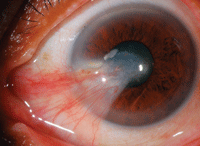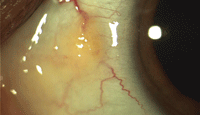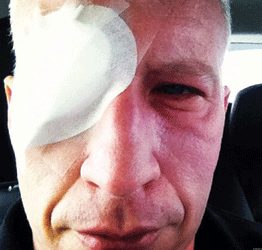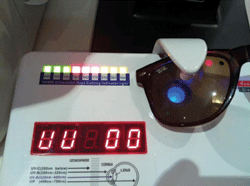Think about what it feels like to be outside, enjoying a sunny summer day. You can feel the warmth of the sun on your face. You’re enjoying the beautiful scenery and hopefully you have your shades on.

Show the patient a close-up look at what UV can do their eye—such as this one with pterygium. It drives the point home that they must wear their sunglasses. Photo: José Miguel Varas, MD/Wikimedia Commons
The sun––although 93 million miles away––makes its presence known with thermal energy and visible light.
However, it’s the unseen ultraviolet radiation (UVR) that’s the problem.
Most people are aware of the dangers of sun exposure to their skin and take appropriate precautions, such as using sunscreen. But most people don’t take the same precautions to protect their eyes from UVR.
A 2013 Vision Council observational study revealed that 40% of adults don’t wear sunglasses while outside—an abysmal statistic on such a major ocular issue with easy-to-implement solutions.1
Unfortunately, this is probably due to inadequate patient education and lack of emphasis on taking action.
But the most influential person, and the one with the biggest opportunity to help, is you, their eye doctor. For our patients to practice what we preach about UVR protection, we first must preach—louder and more often.
Show and Tell
It’s
a simple, yet highly effective, way to engage my patients in a
conversation about UVR.
It helps to serve as a reminder to ask about
their sunwear habits. It gives me an opportunity to back up what I’m
saying.
It’s easy to just to grab them and say: “I have mine, do you
have yours?”
The
custom-branded pair I choose to wear in the office is very inexpensive,
yet 100% UV blocking.
If a patient doesn’t own a pair of sunglasses, it
will become their pair before they leave.
Hopefully, the “sunglass tie” is a fashion trend that will soon sweep optometry.
During the exam, be a UV-educating chatterbox. We know UVR affects nearly every part of the eye, but patients don’t know this. It’s up to us to tell them—and show them. (See “‘Sunglass Tie’ = Fashion + Function.”)
‘Sunglass Tie’ = Fashion + Function
No longer do I wear the standard garb
of a clinician. I’ve swapped out one piece of the usual optometrist’s
outfit with a patient education tool:

Justin Bazan, OD, makes a real fashion statement: “Wear your sunglasses!”
My traditional tie has been
replaced with a pair of sunglasses.
Here is a simple formula that has been proven (in my practice) to educate patients:
1. Describe what you’re looking for.
2. Show what you found.
3. Explain why it’s happening.
4. Inspire action.
5. Ask if they understand and agree to take action.
While performing the slit lamp examination, use the following script to help educate the patient and to inspire them to protect their eyes from UVR damage and the consequences associated with it.
Let’s take the common pinguecula as an example.
1. Describe What You’re Looking For
“I’m taking a close look at the surface of your eye. The powerful UV rays from the sun can often cause serious damage to it. I’ve found some damage to your eye that we need to talk about now.”
UV Conditions Patients Should Know About
UVR can cause damage in a number of
eye-related areas. Patients need to understand the following susceptible
areas and conditions, and have the desire to take preventable action
against them.

Photo: Wikimedia Commons
2. Show What You Found
If you see something, show them.
Showing patients images—whether you use your own imaging system or simply pull up the image on Google—helps drive the point home.
Showing patients a close-up look at their eyes—or what their eyes could look like if they continue not to wear shades—is very persuasive. It often evokes a powerful emotional response that can contribute to solidifying their understanding, leading to them taking action and wearing shades.
Using an exam lane computer, a laptop or an iPad, simply do a Google Image search for “pinguecula,” for example. You’ll see a variety of pingueculae images that range from mild to severe, which will aid you in the education process.
3. Explain Why it’s Happening
Keep your scientific knowledge on a general level to ensure the patient obtains the basic comprehension. You can always get into “p53 tumor suppressor gene expression” and “elastogenesis” afterwards, if the patient expresses interest in more advanced knowledge.
Show them a pinguecula that is similar to theirs, then explain: “Most of the light passes through the front of your eye and ends up being focused on the back of your eye, which allows you to see. However, some of the light ends up being focused into this area. That light contains harmful ultraviolet radiation, which causes damage to the surface of your eye.
Have you ever looked in the mirror and noticed this yellowish area on the white of your eye? This is called a pinguecula, also known as a sun spot. It’s not a big deal right now, but it will be if you don’t help to protect it from the sun and other environmental conditions like the wind.”
4. Inspire Action
Celebrities who capture the attention of your patients provide
eye-catching material for you to use.
One
excellent recent example: Anderson Cooper’s bout with photokeratitis.
There were many online articles, interviews and video clips that all
lent themselves as fodder for education and outreach through social
media.
The next challenge is convincing them to want to take action now.
‘Share’ Your Content
Social
media allows us to engage our patients outside of the office.

Use social media to educate patients. Anderson Cooper’s recent “sun blindness” was a great conversation starter.
We can
have important conversations with them on Facebook, Twitter and newly
emerging social media platforms.
Keep
an eye out for opportunities that provide good subject matter for a
post.
How? Show them moderate and severe pingueculae, and explain:
“If you continue not to wear your shades while outside, the chances of it getting worse are extremely high.
When it gets to this point, not only is it extremely unsightly, it is extremely uncomfortable.
Nobody wants to have red, irritated, uncomfortable eyes all the time.
They really become a problem and treatment is often ineffective, so the best thing you can do is to slow down the progression and help to ensure it never gets to that point.
Are you going to be able to keep your eyes healthy by wearing your sunglasses more often, and not just on sunny summer days, but all throughout the year?”
5. Ask if They Understand and Agree to Take Action
Wait for confirmation that they will do the best they can at preventing future damage, and then ask if they have any questions.
If not, move on to the next discussion point and apply the same formula.
Remind them that it’s pretty easy to protect against UVR. Limit sun exposure and, in addition to sunglasses, use other forms of protection such as wide-brimmed hats.
Contacts that are designed to help block UVR can also play a significant role in protecting their eyes. They can block 90% or more of UVA/B from reaching the cornea and structures located posterior to it.
They are an excellent idea for those forgetful types, and provide an added layer of protection from UVR damage that may still be occurring even with protective eyewear, due to reflected UV and UV that is entering from the sides of the eyewear.
Develop a short but meaningful quote that you can deliver at the summary of the exam: “Your eyes are healthy. The most important thing you can do to keep them that way is to see me annually and make sure to wear your shades. As you now know, the sun is one of the most damaging things to our eyes. Its effects are cumulative, so being better about wearing them now will ensure that your eyes are as healthy as can be down the line.”
From Chair to Sunwear
At the conclusion of the exam, you have an excellent opportunity to hand off a primed patient to the optician, who can help them get the protective eyewear that they now want:
“We discussed UV protection and we agree that it’s extremely important. Please make sure he is fully protected in both his new glasses and sunglasses.”
After the solid in-office education you’ve provided, the patient is now more open and ready for the purchase of sunwear. Be sure to have a selection of shades in the dispensary to take advantage of the patient’s interest.
So,
at the time of booking, be sure that patients are instructed to bring
the glasses and sunglasses they wear most, as well as their contact lens
Rx. This simple request underscores the fundamental importance of
sunwear in the ultimate goal of appropriate UVR protection.
Prepare for Sunwear Before the Appointment
To ensure that a patient develops and
maintains an interest in wearing sunglasses, UVR awareness must start
even before he or she arrives for an exam and continue well after the
individual has left the office.
Appropriately
preparing the patient for his or her visit, using your staff as
educators and providing supplemental online content are all necessary to
help maximize awareness and compliance.
Start Sunwear Early
Children are usually spend more time outside than adults, so their risk of UVR is often greater. And even highly educated parents may believe that UVR damage occurs later in life, and fail to understand that it is the cumulative effect on the eyes, which begins early in life.
Be sure to explain that parents themselves should set a good example by wearing sunglasses.
Fortunately, educating the parents is usually the easy part. Once they realize the risk their children are exposed to, they often take action. Offering reasonably priced sunglasses provides an answer to the often-heard objection: “I’m not spending a lot on a pair they will break or lose the first day they wear them.”
Forming the habit of wearing sunglasses early is helpful in establishing it as a lifelong pattern. Take an active role in achieving sunwear success in children by making the commonly practiced after-exam reward a pair of custom-branded shades.
You’ll soon recoup the small financial outlay for the pair because you have now converted them into a sunglass wearer who most likely will purchase another pair in the future.
Most importantly, you are laying the foundation for a lifetime of UV protection.
Dr. Bazan is in private practice in Brooklyn, NY. He lectures frequently on social media and refractive eye care.
1. The Vision Council. The Big Picture: Eye Protection is Always in Season. May 2013. Available at:
www.thevisioncouncil.org/consumers//media/PDFs/VCUVReport2013FINAL.PDF. Accessed August 16, 2013.
Few
things are as impactful as showing a patient that their sunglasses are
not adequately keeping their eyes protected. It gives us a chance to
talk to them that it is not so much about how much they paid for their
shades, but more about if they bought a reputable brand from a reputable
dealer.
Conduct the UV testing
of their eyewear in front of them. Patients are amazed and impressed.
They are a captive and engaged audience for your tech to educate them on
UV protection.
The
biggest opportunity here is to educate the patient that all eyewear
should be “sunglasses,” meaning that even clear lenses should be
protecting their eyes from UVR.
It is all too common for a patient’s
habitual pair to provide them with less-than-adequate protection.
Our office has made a pledge to Rx-only
lenses that inherently block UVR.
We no longer sell lenses made of
materials that need to be coated to protect eyes from UVR.
We have seen
too many lenses that either were never coated with UV protection or in
which it has worn off. CR39 is no longer an option in our office.
The safest approach is to use a material, like polycarbonate, that inherently provides adequate UV protection.
Because
of the thorough patient education about UVR, most patients in our
practice express a desire for UV protection. For a more complete level
of UV protection, lenses are also treated to minimize the reflected UV
that bounces of the backside of the lens and into their eyes.
When
presented as part of the features of their new lenses, their
understanding affords them a better appreciation of this benefit.
Put Your UV Meter to Work for You
There is a piece of equipment, invaluable
in UV education, that many offices have, yet is often covered under a
layer of dust and tucked into a dark, out-of-the-way cabinet: The UV
meter.
Go and get it out of storage right now.
Move the UV meter
out of the lab dungeon and place it in a highly visible location up
front, preferably in earshot of other patients.

Instruct your patients to bring their sunglasses to the exams. Then put those shades to the test. Many patients will be surprised at the level of UV protection their sunglasses provide—or don’t provide.

